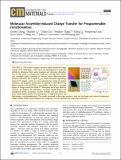Molecular Assembly-Induced Charge Transfer for Programmable Functionalities
Author(s)
Zhang, Zhuolei; Li, Huashan; Luo, Zhipu; Chang, Shuquan; Li, Zheng; Guan, Mengmeng; Zhou, Ziyao; Liu, Ming; Grossman, Jeffrey C; Ren, Shenqiang; ... Show more Show less
DownloadAccepted version (5.215Mb)
Terms of use
Metadata
Show full item recordAbstract
© 2017 American Chemical Society. The donor-acceptor interface within molecular charge transfer (CT) solids plays a vital role in the hybridization of molecular orbitals to determine their carrier transport and electronic delocalization. In this study, we demonstrate molecular assembly-driven bilayer and crystalline solids, consisting of electron donor dibenzotetrathiafulvalene (DBTTF) and acceptor C60, in which interfacial engineering-induced CT degree control is a key parameter for tuning its optical, electronic, and magnetic performance. Compared to the DBTTF/C60 bilayer structure, the DBTTFC60 cocrystalline solids show a stronger degree of charge transfer for broad CT absorption and a large dielectric constant. In addition, the DBTTFC60 cocrystals exhibit distinct CT arrangement-driven anisotropic electron mobility and spin characteristics, which further enables the development of high-penetration and high-energy γ-ray photodetectors. The results presented in this paper provide a basis for the design and control of molecular charge transfer solids, which facilitates the integration of such materials into molecular electronics.
Date issued
2017Department
Massachusetts Institute of Technology. Department of Materials Science and EngineeringJournal
Chemistry of Materials
Publisher
American Chemical Society (ACS)